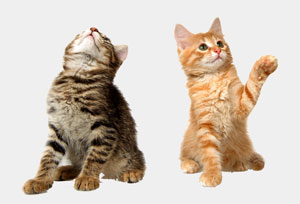Kitten and Cat Vaccination Schedule
Vaccinations by Age
 Core Vaccines
Core Vaccines
6, 9, 12 & 16 Weeks Panleukopenia (distemper)-Killed, Rhinotracheitis, Calicivirus
12 Weeks* Rabies
Optional Non-Core Vaccines
8 & 12 Weeks Leukemia
8, 10 & 12 Weeks FIV
9 & 12 Weeks Chlamydia
*Follow label directions for booster shots
Shop our Cat Vaccines
Common Feline Diseases
Rabies
Of all animal diseases, rabies is probably the most feared. The rabies virus attacks the brain and is always fatal. Most pets are exposed to rabies by bites from wild animals, particularly skunks, raccoons, bats and foxes. The disease can be transmitted to humans through the bite of an infected pet. Vaccination of all dogs and cats is the most effective means of control.
Feline Panleukopenia
Feline Panleukopenia, sometimes called "feline distemper", causes severe vomiting, diarrhea and dehydration. It is the most widespread disease of cats and causes high death loss, especially among kittens. The disease is caused by a virus and is highly contagious.
Feline Rhinotracheitis
Rhinotracheitis infection is a widespread respiratory disease caused by a virus. It is most severe in small kittens and can cause profuse discharge from the eyes and nose. Feline Calicivirus Calicivirus infection causes a variety of symptoms including fever, excess salivation and mouth or tongue ulcers. It is usually less fatal than rhinotracheitis or panleukopenia.
Feline Calicivirus
Calicivirus infection causes a variety of symptoms including fever, excess salivation and mouth or tongue ulcers. It is usually less fatal than rhinotracheitis orpanleukopenia.
Feline Pneumonitis
Respiratory infection with symptoms resembling feline viral rhinotracheitis. The disease is caused by the organism Chlamydia psittaci and can be complicated by associated bacterial infections.
Feline Leukemia
Feline Leukemia is a form of cancer in cats which is usually fatal. The disease, caused by a virus, can lead to tumor growth nearly anywhere in the body as well as a variety of other symptoms. Infected cats are unable to resist other diseases and may die from associated infections. Testing for the disease is recommended prior to initiating a Leukemia vaccination program.
Ringworm
Ringworm is a fungal infection of the hair and skin layers that affects many species, including humans. In almost all instances, the causitive agent in cats is a dermatophyte (fungus) called Microsporum canis which grows only in non-living skin tissue such as hair, the outermost layer of the skin and nails. Ringworm is highly contagious, with thousands of organisms.
Feline Infectious Peritonitis (FIP)
FIP is a disease caused by a coronavirus. This virus is spread by direct cat to cat contact or by contact with contaminated surfaces. There are 2 manifestations of the disease, wet and dry, and both have nonspecific symptoms such as intermittent inappetence, depression, rough hair coat, weight loss, and fever. There is no cure and the disease is considered fatal.
Feline Giardiasis
Giardiasis in dogs, cats and humans is caused by a waterborne parasite called Giardia lamblia. The parasite is found in untreated water, i.e. puddles, ponds and creeks. Symptoms include severe diarrhea, weight loss, fever, dehydration and nausea.
Cat Vaccinating Tips
To administer a vaccine subcutaneously: Simply pick up the skin, insert the needle, draw back on the plunger (aspirate), and inject. If blood appears, it means the tip of the needle is in a vessel. Merely withdraw the needle and select another site. If air is drawn in freely, the tip of the needle is not under the skin; reposition needle and aspirate again.
To administer a vaccine intramuscularly: Some vaccines must be given intramuscularly (IM). The best site for this is in the muscle of the rear leg, between the hip and knee. Aspirate as with the subcutaneous injection.
Mixing two-part vaccines: Some vaccines require mixing. They come in 2 vials, one containing the liquid portion and the other containing the dried portion. To mix, first draw the liquid portion into the syringe. Inject the liquid into the dried portion and mix until dissolved. Draw the mixture back into syringe.


